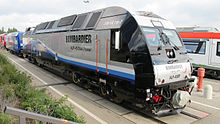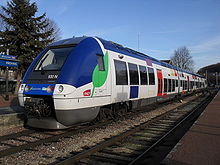- Electro-diesel locomotive
-
Not to be confused with Diesel-electric locomotive.
 FEVE electro-diesel locomotive 1901 at Santa Agueda (Vizcaya).
FEVE electro-diesel locomotive 1901 at Santa Agueda (Vizcaya).
An Electro-diesel locomotive (also referred to as dual-mode locomotive) is powered either from an electricity supply (like an electric locomotive) or by using the onboard diesel engine (like a diesel-electric locomotive). For the most part, these locomotives are built to serve regional, niche markets with a very specific purpose.
Contents
Overview
Electro-diesel locomotives and electro-diesel multiple units are used to provide continuous journeys along routes that are only partly electrified without a change of locomotive, extensive running of diesel under the wires or where diesel engines are banned. They may be designed or adapted mainly for electric use, mainly for diesel use or to work well as either electric or diesel.
Primarily electric
 British Rail Class 73, no. E6013 (73107) at Rowsley South, on the Peak Railway on 17th April 2003. This locomotive was on loan from Fragonset Railways, and has since returned to main-line service with RT Rail.
British Rail Class 73, no. E6013 (73107) at Rowsley South, on the Peak Railway on 17th April 2003. This locomotive was on loan from Fragonset Railways, and has since returned to main-line service with RT Rail.
This is effectively an electric locomotive with a relatively small auxiliary diesel engine intended only for low-speed or short-term operation (e.g. British Rail Class 73). Some of these, such as the British Rail Class 74, were converted from electric locomotives. The Southern Region of British Railways used these locomotives to cross non-electrified gaps and to haul boat trains which used tramways at the ports of Southampton and Weymouth.
Primarily diesel
This is effectively a diesel locomotive with auxiliary electric motors (or connections to the existing traction motors), usually operating from 750 V DC third rail where non-electric traction is banned (e.g. EMD FL9). The primary function for these models is to provide a one-seat ride between diesel territory and the New York City terminals of Grand Central Terminal and Penn Station, which have ordinances prohibiting locomotives from emitting smoke within their tunnels. Once out of the tunnels, the third-rail shoes are retracted and operation is as a normal diesel locomotive.
Full dual-mode
With modern electronics, it is much easier to construct (or adapt) an electro-diesel locomotive or multiple-unit which is equally at home running at high speeds both under the wires and under diesel power (e.g. SNCF Class B 82500). These will normally operate under pure electric traction where possible, and use the diesel engines to extend the journeys along non-electrified sections which would not be cost effective to electrify. They may also be used on long cross-country routes to take advantage of shorter sections of electrified main lines.
Europe
France
SNCF B82500 electro-diesel multiple unit at Provins.
Bombardier has built dual-mode variants of its AGC series for the French operator SNCF; the electricity is collected by means of a pantograph.
- B 81500 – multiple unit trains using 1.5 kV DC catenary, in service since 2005
- B 82500 – multiple unit trains using both 1.5 kV DC and 25 kV AC catenary, currently still being built
Germany
- Gmeinder class 478.6 diesel and 750 V DC third-rail (bottom contact).
- Voith Futura, a concept locomotive rebuilt from DB 240 002.
- Bombardier TRAXX "Last Mile Diesel", mainly electric. Orders signed 2010, to be delivered probably 2012.[1]
Russia
In Russia, a number of electro-diesels were built which had both pantographs and diesel motors; these locomotives were actually multiple-units, with distinct electric, diesel, and motor sections. These included:
- ED16 (ЭД16), ED18 (ЭД18), and TEU1 (ТЭУ1) narrow gauge models
- OPE1 (ОПЭ1), OPE2 (ОПЭ2), NP1 (НП1), PE2(M) (РЭ2(М)), and EL20 standard-gauge locomotives used mostly in quarries
Spain
- FEVE 1.900 Series, 1500 V DC overhead wires. This series is a rebuild of FEVE 1.000 Series locomotive.
- CAF Bitrac 3600, 3000 V DC overhead wires. October 2007 order for 9 freight Co-Co locomotives. Available in Bo-Bo and Co-Co wheel configuration, 1,435 or 1,668 mm (56.5 or 65.7 in) gauge, and as freight or passenger versions of 120 and 180 km/h (75 and 110 mph) maximum speeds respectively[2].
Switzerland
 Light dual-mode (electric and diesel) shunter SBB Tem 346 at work.
Light dual-mode (electric and diesel) shunter SBB Tem 346 at work.
- Rhaetian Railway Gem 4/4, 1000 V DC overhead wires (Bernina Railway)
- SBB Tem346 shunters (see image).
- SBB Eem923 shunters using both 15kV 16·7Hz and 25kV 50Hz overhead wires and a 360 kW auxiliary diesel engine are on order from Stadler Winterthur[3].
United Kingdom
An experimental electro-diesel locomotive, DEL120, was built by London Underground in 1940 but was not a success. Only two other types have been built. In both cases, their electricity source was a 750 V DC third rail.
- British Rail Class 73, dating from 1962 – the more successful design, with some still in regular use. They have lower power output in the diesel mode.
- British Rail Class 74 – rebuilt from British Rail Class 71 electric locomotives in 1967 and withdrawn by 1977.
The Hitachi Super Express trains proposed for the electrification of the Great Western Main Line have a variant able to operate in bi-mode as an electro-diesel trainset. This would enable intercity services from Paddington Station to continue beyond Cardiff Central railway station, currently the western limit of the proposed electrification scheme.
Bombardier has plans,[4] apparently known as Operation Thor or Project Thor, to convert 500 existing diesel multiple units (DMUs) into electro-diesel multiple units (EDMUs).[5] Whilst exact details are unclear, one source specifies that these would involve their Voyager family DEMUs, and entail the construction of additional intermediate cars with a pantograph and a transformer which would feed power into the traction motors of the existing diesel-electric cars when running off overhead lines.[6]
North America
United States
- GE three-power boxcab a switcher locomotive model built in 1930, also capable of operating as a battery locomotive retired from service.
Several primarily diesel locomotive types and a multiple-unit have been built to operate off a 750 VDC third rail into the New York City terminals of Grand Central Terminal and Penn Station:
- Baldwin RP-210 – primarily diesel-hydraulic, third-rail electric mode for short-term use only; these have been retired from passenger service.
- Roger Williams streamlined, six car, lightweight, DMU passenger train, built by the Budd Company in 1956 for the New York, New Haven and Hartford Railroad – primarily diesel-hydraulic, third-rail electric mode for short-term use only; this has been retired from passenger service.
- Fairbanks Morse P-12-42 – primarily diesel-electric, third-rail electric mode for short-term use only; these have been retired from passenger service.
- EMD FL9 – primarily diesel-electric, third-rail electric mode for short-term use only; these have been retired from passenger service.
- P32AC-DM – dual-mode version of the GE Genesis, electric mode is only used for a few miles of travel.
- EMD DM30AC – specific to the Long Island Rail Road.
Additionally, a full dual-mode 200/160 km/h locomotive for use with catenary is now under test[7].
- Bombardier ALP-45DP - 36 locomotives are on order by New Jersey Transit, to bridge gaps between non-electrified and electrified sections of track into New York Penn Station.[8][9]
Canada
- Bombardier ALP-45DP - 20 locomotives are on order for the Repentigny-Mascouche Line (AMT). It is a joint order with the New Jersey Transit order above.[8] They will provide a through journey on this mostly un-electrified new line, which joins an existing electrified commuter line to access Montreal's Central Station through the poorly ventilated, 25 kV AC electric only Mount Royal Tunnel.[8]
Africa
South Africa
The South African Class 38-000 is a 3kV DC electro-diesel locomotive designed by Consortium under the leadership of Siemens and built by Union Carriage and Wagon (UCW) in Nigel, Gauteng, South Africa. Between November 1992 and 1993 fifty of these locomotives were placed in service by Spoornet, formerly the South African Railways (SAR) and later renamed Transnet Freight Rail (TFR). The diesel engine enables the locomotive to shunt on unelectrified sidings.
Hybrid locomotive
Main article: Hybrid locomotive Railpower Technologies "Green Goat" hybrid switching locomotive.
Railpower Technologies "Green Goat" hybrid switching locomotive.
A specialized type of electro-diesel locomotive is the hybrid locomotive. Here, the electricity comes from a battery (charged by the diesel engine) rather than an external supply. An example is the Green Goat switcher[10].
See also
- Biodiesel
- Global warming
- Three power locomotive
- Hitachi Super Express, a future train in the United Kingdom.
References
- ^ "Bombardier launches Traxx electro-diesel". Railway Gazette International. 10 May 2011. Archived from the original on 10 May 2011. http://www.webcitation.org/5yc5HJwr3. Retrieved 11 May 2011.
- ^ "Electro-diesel loco offers flexible traction". Railway Gazette International. 2008-01-03. http://www.railwaygazette.com/nc/news/single-view/view/electro-diesel-loco-offers-flexible-traction.html. Retrieved 2010-12-02.
- ^ "Electro-diesel shunter order". Railway Gazette International. 2010-07-08. http://www.railwaygazette.com/nc/news/single-view/view/electro-diesel-shunter-order.html. Retrieved 2010-12-02.
- ^ "Colin Walton: Railway man trying to keep Bombardier on track". The Independent. 2010-06-17. http://www.independent.co.uk/news/people/profiles/colin-walton-railway-man-trying-to-keep-bombardier-on-track-2002578.html. Retrieved 2011-03-04.
- ^ "Transport and the economy: Memorandum from Bombardier Transportation UK Limited (TE 89)". Parliament of the United Kingdom. 10 November 2010. http://www.publications.parliament.uk/pa/cm201011/cmselect/cmtran/writev/economy/te89.htm. Retrieved 2011-03-04. "Project Thor, being developed with a number of UK private sector partners, would see 500 existing diesel multiple unit vehicles converted to bi-mode diesel / electric capability, allowing them to operate as electric trains where there is already electrification infrastructure in place, while continuing their journey in diesel mode where the wires end."
- ^ "Bombardier’s electrification plan presented to ministers". Rail-News.com. 2010-10-06. http://rail-news.com/2010/10/06/bombardiers-electrification-plan-presented-to-ministers/. Retrieved 2011-03-04. "Train builder Bombardier has presented ministers with an offer to construct 123 pantograph vehicles and convert 21 existing vehicles in the 22x fleet into EDMUs."
- ^ "ALP-45DP electro-diesel locomotive debut". Railway Gazette International. 2010-09-23. http://www.railwaygazette.com/nc/news/single-view/view/alp-45dp-electro-diesel-locomotive-debut.html. Retrieved 2010-12-02.
- ^ a b c "Bombardier to supply electro-diesel locos". Railway Gazette International. 2008-08-19. http://www.railwaygazette.com/nc/news/single-view/view/bombardier-to-supply-electro-diesel-locos.html. Retrieved 2010-12-02.
- ^ "NJ Transit approves FY2011 spending". Railway Gazette International. 2010-07-19. http://www.railwaygazette.com/nc/news/single-view/view/nj-transit-approves-fy2011-spending.html. Retrieved 2010-12-02.
- ^ http://www.railpower.com/products_gg.html
- http://www.caf.net/ingles/prensa/nota_prensa.php?id=9
- http://www.caf.net/img/prensa/notprensa/20080428102327Railway_Gazette_01_2008.pdf
- http://www.br146.de/indexj.htm (see document 'Dual Power (pdf, neu)')
- http://bombardier.com/files/en/supporting_docs/BT-ECO4-MITRAC_Hybrid.pdf
External links
- Pictures of the Russian OPE-1 locomotives
- Pictures of the Russian electro-diesels
- (Russian) Novocherkasskiy electric locomotive factory – Model OPE1
Railway electrification List of systems · Railway electrification system · Railway electric traction · Traction substation · Traction power network · Pantograph · Power car · Electric locomotive · Electric multiple unit · Electro-diesel locomotive · Multi-system · Overhead lines · Third rail · Trolley pole · Conduit current collection · Ground level power supply · Stud contact system ·
By country : Australia · Great Britain · India · Iran · Japan · Malaysia · Norway · Sweden · Turkey · United States
Electro-diesel locomotives of North America GE three-power boxcab • Baldwin RP-210 • Fairbanks Morse P-12-42 • EMD FL9 • GE P32AC-DM • EMD DM30AC • ALP-45DPCategories:- Electro-diesel locomotives
- Hybrid locomotives
Wikimedia Foundation. 2010.






